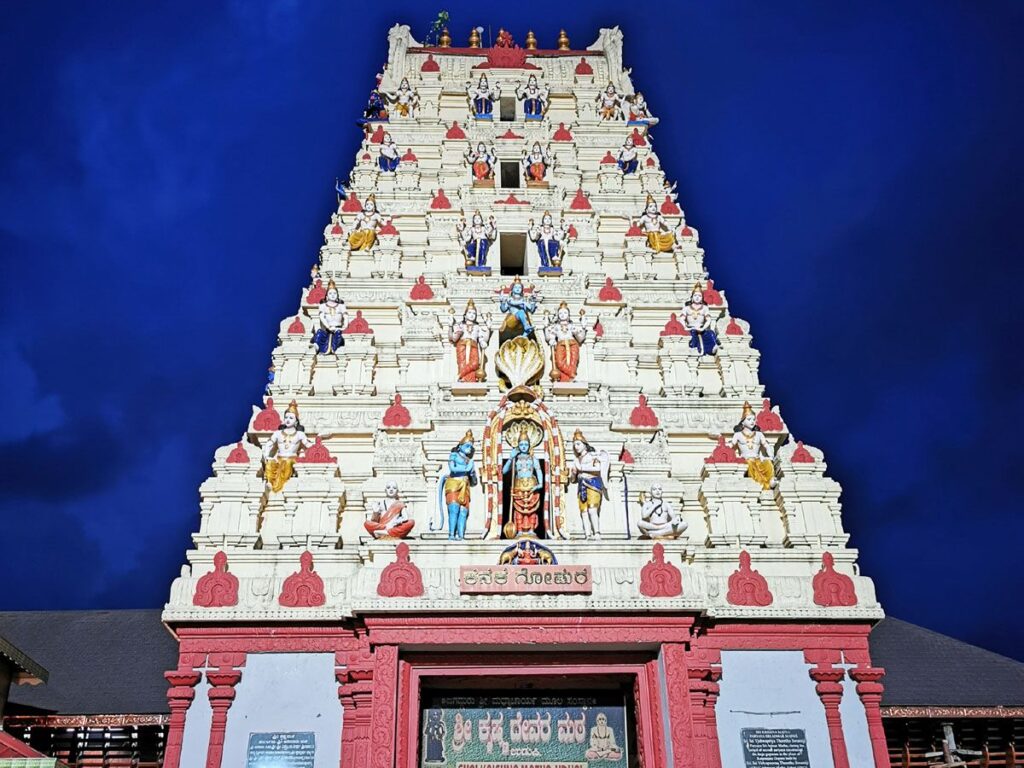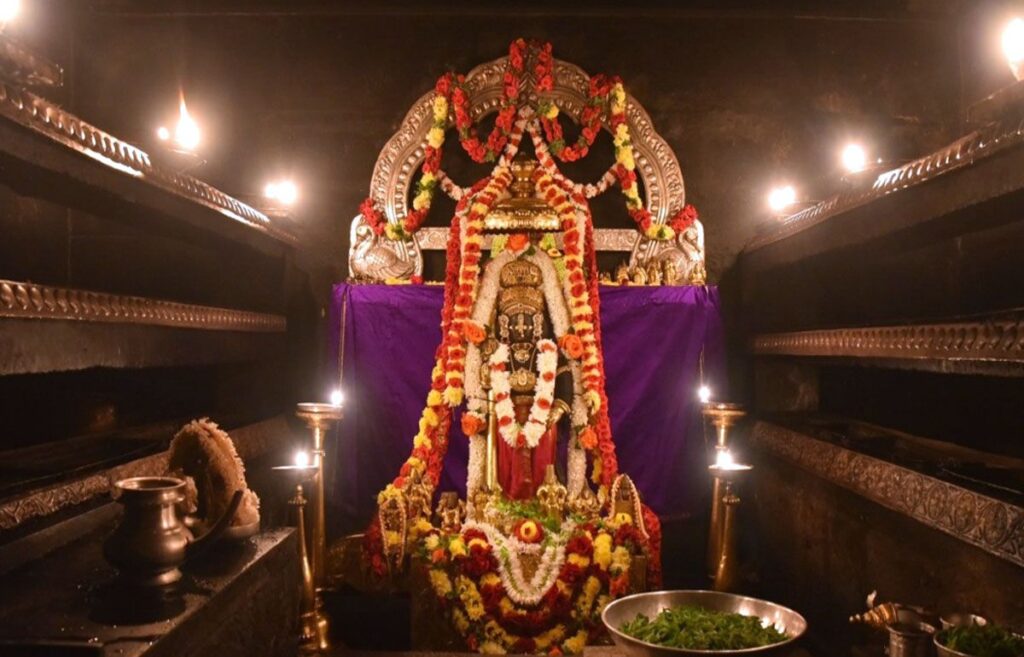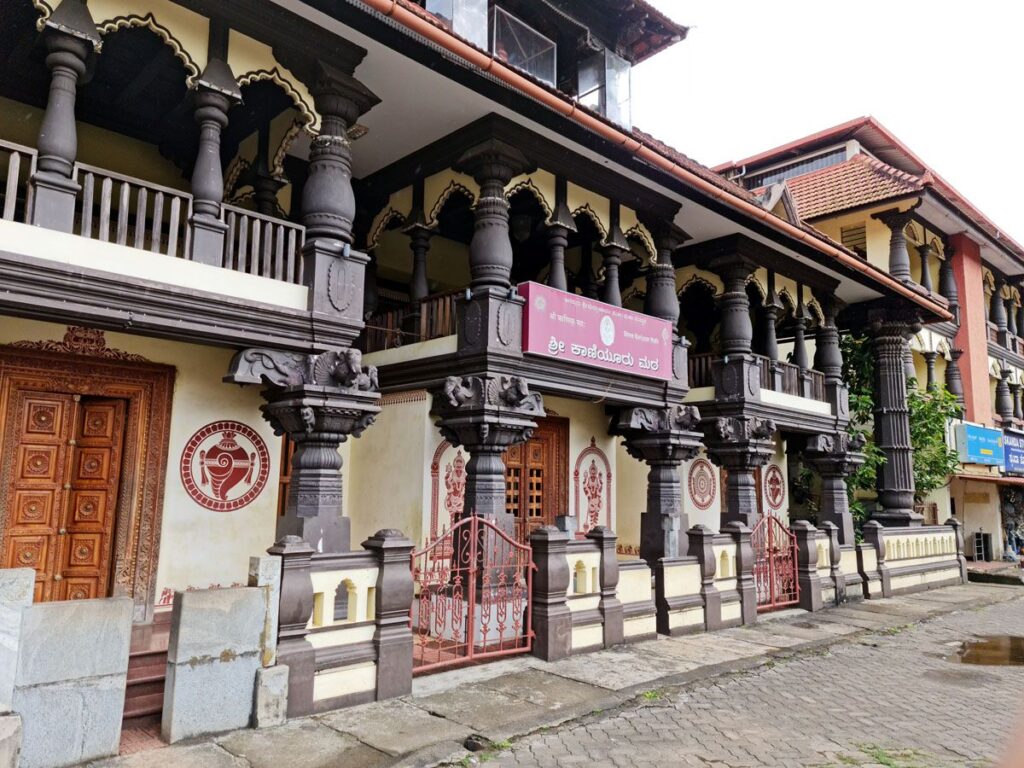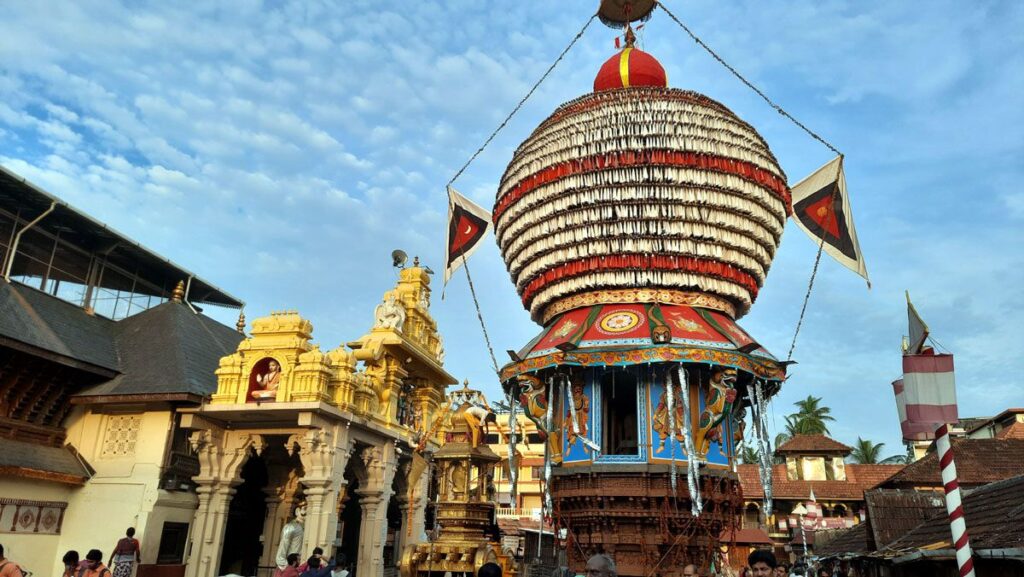Udupi Sri Krishna Temple: Mathura of South India
The Udupi Sri Krishna Temple, also known as Udupi Sri Krishna Matha, is a highly revered Hindu temple dedicated to Lord Krishna. Located in the coastal town of Udupi in Karnataka, India, the temple is famous for its unique traditions, rich history, and spiritual significance.

Contents
- 1 Udupi Sri Krishna Temple History:
- 2 Legend of Udupi Sri Krishna Temple:
- 3 Significance of Udupi Sri Krishna Temple:
- 4 Myths and Beliefs of Udupi Sri Krishna Temple:
- 5 Udupi Sri Krishna Temple Timing & Rituals:
- 6 Places to visit near Udupi Sri Krishna Temple:
- 7 FAQ:
- 7.1 What is Udupi Sri Krishna Temple?
- 7.2 Who founded the temple?
- 7.3 What is unique about the temple?
- 7.4 What are the main attractions of the temple?
- 7.5 Is there any dress code for visiting the temple?
- 7.6 What are the temple timings?
- 7.7 Can non-Hindus visit the temple?
- 7.8 Are there any festivals celebrated at the temple?
- 7.9 How can one reach Udupi Sri Krishna Temple?
- 7.10 Is there accommodation available near the temple?
- 7.11 Are there any rules or guidelines to be followed while visiting the temple?
- 8 How to reach Udupi Sri Krishna Temple:
- 9 Google Maps:
Udupi Sri Krishna Temple History:
Founder and Philosophy:
- Madhvacharya: The temple and matha (monastery) were established by the revered Vaishnava saint Jagadguru Sri Madhvacharya (1238-1317). He was the founder of the Dvaita Vedanta school of philosophy, emphasizing dualism and the independence of the soul from God.
Story of the Idol:
- Unearthing Krishna: Legend says Madhvacharya found the idol of Lord Krishna buried in the sand while walking on the banks of the sacred Saraswati River. The idol is believed to be a self-manifested (swayambhu) form of Lord Krishna in his childhood form ( बालकृष्ण – Balakrishna).
Unique Practices:
- Nine Windows: Unlike most Krishna temples where the deity is directly visible, devotees here worship Krishna through nine windows (Navagraha Kitiki) representing the nine celestial bodies in Hindu astrology. This practice is said to have been established by Madhvacharya.
Eight Mutts:
- Management System: The unique management system of the temple involves eight mutts (monasteries) that take turns managing the temple for a period of two years each. This practice, known as Paryaya, ensures collective responsibility and avoids hereditary control.
Read More>> Paramekkavu Bhagavathi Temple
Historical Significance:
- Mathura of the South: Udupi is often referred to as the “Mathura of the South,” drawing a parallel to Lord Krishna’s birthplace in North India. The Udupi Sri Krishna Temple has become a prominent pilgrimage destination for Vaishnavites (devotees of Vishnu) in South India.
Kanakadasa and the Kanakana Kindi:
- Inclusivity and Devotion: A famous story associated with the Udupi Sri Krishna Temple is that of Kanakadasa, a saint from a lower caste who was initially denied entry due to social norms. His ardent devotion led to a miracle where Lord Krishna turned his idol to face the wall behind the temple, allowing Kanakadasa to have darshan (viewing the deity) through a small hole in the wall. This spot is now known as the Kanakana Kindi.
Continuous Tradition:
- Living Temple: The Udupi Sri Krishna Matha and temple have thrived for centuries, maintaining a rich tradition of scholarship, philosophy, and devotion. They continue to be a vibrant center of Hinduism and a popular pilgrimage site.
Read More>> Kamadeswarar Kalikambal Temple Chennai

Legend of Udupi Sri Krishna Temple:
The Lost Bala Krishna Idol:
- The legend centers around Madhvacharya, a revered 13th-century saint and philosopher who founded the Dvaita Vedanta school of Hinduism.
- Madhvacharya desired to establish a temple dedicated to Lord Krishna in Udupi.
- According to the legend, a magnificent idol of Bala Krishna (child Krishna) originally resided in Dwarka, a holy city believed to be Krishna’s earthly kingdom.
- Tragically, a massive flood devastated Dwarka centuries before Madhvacharya’s time, and the Bala Krishna idol was lost at sea.
Divine Intervention & The Reappearance:
- Madhvacharya, determined to find the idol, prayed fervently. His devotion is said to have pleased Lord Krishna.
- Miraculously, a giant ball of gopichandana (clay used for religious markings) washed ashore near Udupi. Gopichandana holds special significance in Vaishnavism, the Krishna-worshipping tradition.
- Madhvacharya, with divine guidance, understood that the idol of Bala Krishna was hidden within the gopichandana ball.
The Enshrined Deity:
- With the help of his disciples, Madhvacharya carefully broke open the gopichandana ball. Inside, they discovered the beautiful idol of Bala Krishna, perfectly preserved.
- This miraculous discovery is believed to be how the Udupi Sri Krishna Matha came to be. Madhvacharya enshrined the idol in the temple, facing east as per tradition.
The Kanakadasa Window:
- Another interesting part of the legend involves Kanakadasa, a saint-poet from a lower caste. He longed to have darshan (viewing) of the Lord but was denied entry due to social restrictions of the time.
- Undeterred, Kanakadasa sat outside the Udupi Sri Krishna Temple and poured his heart out in devotional songs. Pleased by his devotion, Lord Krishna is said to have turned the idol westward for a brief moment, granting Kanakadasa darshan.
- A small window on the west side of the shrine, known as the “Kanakadasa Kindi,” is believed to be the spot where this divine act occurred.
Significance of the Legend:
- The legend of the Udupi Sri Krishna Matha highlights the power of faith and devotion. Madhvacharya’s unwavering dedication is said to have brought the idol back to light.
- It also emphasizes the universality of Krishna’s grace, as shown in the story of Kanakadasa.
Read More>> Andarkuppam Murugan Temple Ponneri

Significance of Udupi Sri Krishna Temple:
Religious Importance:
- Dvaita Vedanta Center: Founded by Madhvacharya, a revered saint in the 13th century, the temple is the central point for the Dvaita Vedanta school of philosophy. This philosophy emphasizes devotion to Vishnu and the concept of dualism (between atman and Brahman).
- Krishna Balarama Deities: The temple enshrines a unique idol of Lord Krishna as a child (Balakrishna) along with his brother Balarama. Devotees visit seeking blessings for well-being, both material and spiritual.
- Eight Maths System: The Udupi Sri Krishna Temple complex is part of a unique system of eight maths (monasteries) that rotate the responsibility of managing the temple rituals and offerings. This system has been in place for centuries and ensures the temple’s smooth functioning.
Historical Significance:
- Ancient Origins: While the exact date of construction remains unclear, some believe the temple might date back to the 8th or 9th century. The adjoining Anantheshwara Temple within the complex is known to be even older.
- Architectural Marvel: The temple complex showcases a blend of architectural styles, with influences from Dravidian and Hoysala styles. It’s a testament to the craftsmanship and artistic traditions of the region.
Cultural Importance:
- Udupi Krishna’s Legend: A popular legend narrates how Madhvacharya discovered the idol of Krishna floating in the sea. This story adds to the temple’s mystique and cultural significance.
- Vegetarian Cuisine: Udupi is known for its vegetarian cuisine, and the Udupi Sri Krishna Temple has played a role in shaping this culinary tradition. Temple prasad (blessed food) offerings are often vegetarian and have influenced local food habits.
- Part of the Char Dham of South India: Considered the “Mathura of South India,” Udupi is one of the four important pilgrimage sites (Char Dham) revered by Vaishnavites in South India.
Read More>> Nambunayaki Amman Temple Rameswaram

Myths and Beliefs of Udupi Sri Krishna Temple:
- Miraculous Discovery of the Idol: A popular legend narrates how Madhvacharya, the founder of the temple, found the idol of Lord Krishna floating in the Arabian Sea while praying. He believed it was originally worshipped by Arjuna from the Mahabharata epic. This miraculous discovery story strengthens the temple’s importance and connection to Krishna.
- Kanakana Kindi: Another well-known story revolves around Kanakadasa, a poet-saint from a lower caste. Denied entry due to social norms, Kanakadasa sang devotional songs outside the temple. Miraculously, the temple wall split open, allowing him a view of the deity. This event, known as “Kanakana Kindi,” symbolizes the temple’s universality and the accessibility of divine grace for all devotees regardless of caste.
- Eight Maths and the Churning Rod: The unique system of eight maths (monasteries) that manage the temple has its own legend. It’s believed that during the annual Paryaya festival, when the leadership of the temple rotates among the maths, a divine selection process takes place. A churning rod used to hoist the Udupi Sri Krishna Temple flag is said to miraculously bend towards the residence of the math chosen for the next leadership role.
- Healing Powers of Udupi Krishna: Devotees hold a strong belief in the healing powers of Udupi Krishna. Many recount stories of miraculous recoveries from illnesses after seeking blessings with unwavering faith.
Beyond Myths:
- Strict Daily Rituals: The temple follows a unique set of daily rituals focused on the deity as a child Krishna. This includes waking him up, bathing him, offering him food (bhoga), and putting him to sleep at night. These rituals are seen as a way to connect with the playful and endearing form of Lord Krishna.
Read More>> 6th CE Sarangapani Temple Kumbakonam

Udupi Sri Krishna Temple Timing & Rituals:
Temple Timings:
- Generally Open: The Udupi Sri Krishna Temple remains open throughout the day, with timings typically ranging from 4:30 AM to 9:00 PM.
Darshan Timings:
- While the Udupi Sri Krishna Temple is open for most of the day, there might be short breaks in between for rituals and cleaning. Here’s a general guideline for darshan timings:
- Morning Darshan: 4:30 AM to around 9:00 AM
- Afternoon Darshan: After the completion of mid-day rituals (around 12:30 PM) till about 5:00 PM
- Evening Darshan: 6:00 PM to 8:30 PM
Daily Rituals:
The Udupi Sri Krishna Temple follows a unique daily routine centered around the idol of Lord Krishna as a child (Balakrishna). Here are some of the main rituals:
- Suprabhata Seva: (4:30 AM) – Waking the deity with prayers and hymns.
- Abhisheka: (Time varies) – A sacred bath ceremony performed with milk, curd, ghee, and other items. This can be a special ceremony offered by devotees with booking required.
- Mangalarati: (Morning Aarti) Offered after the abhisheka or at around sunrise.
- Naivedya: (Mid-day offering) Offering of food (bhoga) to the deity, typically around 12:30 PM.
- Panchamrtha Pooja: (Afternoon) Offering of panchamrita (a mixture of five nectars) to the deity. Specific timing might vary.
- Sayana Aarti: (Evening Aarti) Marking the end of the day around 8:30 PM.
- Shanti Pooja: (Night) Performed before closing the Udupi Sri Krishna Temple for the night.
Places to visit near Udupi Sri Krishna Temple:
- Anantheshwara Temple: Located adjacent to the Udupi Sri Krishna Temple, the Anantheshwara Temple is dedicated to Lord Shiva. It’s famous for its intricate carvings and architecture.
- Manipal: Just a few kilometers away from Udupi, Manipal is known for its educational institutions, lush greenery, and serene ambiance. You can visit the Manipal End Point, Manipal Lake, and various cultural centers in the area.
- Malpe Beach: Situated around 6 kilometers from Udupi, Malpe Beach is known for its golden sands, clear blue waters, and picturesque surroundings. You can enjoy activities like swimming, boating, and beach games here.
- St. Mary’s Island: Accessible by ferry from Malpe Beach, St. Mary’s Island is famous for its unique rock formations, pristine beaches, and clear waters. It’s a great spot for nature lovers and photographers.
- Kaup Beach: Located about 12 kilometers from Udupi, Kaup Beach is known for its lighthouse, golden sands, and breathtaking sunsets. You can also visit the nearby Kaup Lighthouse for panoramic views of the coastline.
- Krishna Mutt: Apart from the Udupi Sri Krishna Temple, you can explore the Krishna Mutt complex, which includes the Chandreshwara Temple, Raghavendra Mutt, and various other shrines.
- Pajaka: About 10 kilometers from Udupi, Pajaka is the birthplace of Sri Madhwacharya, the founder of the Dvaita school of philosophy. You can visit the Madhwacharya Birthplace Shrine and learn about his life and teachings.
- Kapu Beach: Situated around 18 kilometers from Udupi, Kapu Beach is known for its lighthouse, sandy shores, and tranquil atmosphere. It’s a popular spot for picnics and relaxation.
FAQ:
What is Udupi Sri Krishna Temple?
Udupi Sri Krishna Temple is a historic Hindu temple dedicated to Lord Krishna, located in the town of Udupi in Karnataka, India. It is one of the most famous pilgrimage sites for followers of Vaishnavism.
Who founded the temple?
The Udupi Sri Krishna Temple was founded by the 13th-century saint and philosopher, Sri Madhvacharya, who was a proponent of the Dvaita school of Vedanta philosophy.
What is unique about the temple?
The temple is renowned for its unique traditions and practices, including the mode of worship called “Paryaya” where the responsibility of managing the temple and performing rituals is handed over to a new Swami (head priest) every two years.
What are the main attractions of the temple?
- Sanctum Sanctorum: The central deity is Lord Krishna, worshipped here in the form of a statue holding a mace in the right hand and a conch in the left.
- Kanakana Kindi: A small window through which devotees can have a darshan (view) of Lord Krishna.
- Anna Prasada: The temple serves delicious vegetarian food to thousands of devotees every day, known as “Anna Prasada.”
Is there any dress code for visiting the temple?
Yes, there is a dress code to be followed when visiting the temple. Men are required to remove their shirts and vests before entering the inner sanctum, and both men and women are expected to dress modestly.
What are the temple timings?
The temple is open for darshan (worship) from early morning till late in the evening. However, specific timings may vary depending on the day and festival schedules.
Can non-Hindus visit the temple?
Yes, non-Hindus are allowed to visit the temple and participate in the darshan and other activities, but they are expected to respect the traditions and customs of the temple.
Are there any festivals celebrated at the temple?
Yes, the temple celebrates various festivals throughout the year, including Krishna Janmashtami, Makara Sankranti, and Ratha Yatra, among others. These festivals attract a large number of devotees from all over the country.
How can one reach Udupi Sri Krishna Temple?
Udupi is well-connected by road, rail, and air. The nearest airport is Mangalore International Airport, and the town is also well-connected by trains and buses from major cities in Karnataka and neighboring states.
Is there accommodation available near the temple?
Yes, there are several hotels, guesthouses, and lodges available in Udupi town to suit various budgets. Many of them are located within walking distance from the temple.
Are there any rules or guidelines to be followed while visiting the temple?
Visitors are expected to maintain cleanliness and silence within the temple premises. Photography may be restricted in certain areas, and it is advisable to follow the instructions given by the temple authorities and staff.
How to reach Udupi Sri Krishna Temple:
- By Air:
- The nearest airport to Udupi is the Mangalore International Airport (IXE), located about 60 kilometers away. From the airport, you can hire a taxi or take a bus to reach Udupi. Mangalore airport is well-connected to major cities in India, including Mumbai, Bangalore, Chennai, and Delhi.
- By Train:
- Udupi Railway Station is well-connected to major cities like Bangalore, Mangalore, Mumbai, and Chennai via regular train services. The railway station is located in the heart of the city, and you can easily find taxis, auto-rickshaws, or buses to reach the Udupi Sri Krishna Temple.
- By Road:
- Udupi is well-connected to various cities and towns in Karnataka and neighboring states by road. You can reach Udupi via national highways and state highways. The city has a good network of roads, and you can either drive your own vehicle or take a bus operated by the state transport corporation or private operators.
- If you’re traveling from Mangalore, Bangalore, or other nearby cities, you can easily reach Udupi by road within a few hours.







One Comment